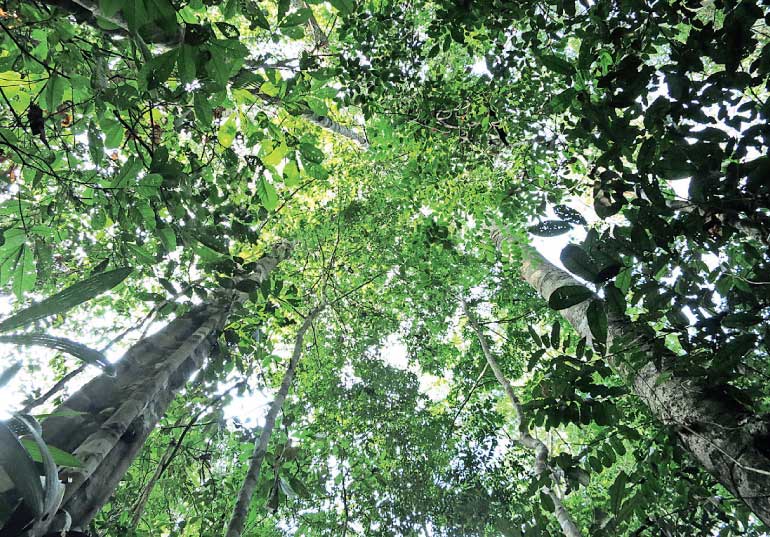Friday Dec 05, 2025
Friday Dec 05, 2025
Monday, 22 May 2017 00:01 - - {{hitsCtrl.values.hits}}
 By Yurdi Yasmi
By Yurdi Yasmi
Ending poverty by 2030 on our planet is a global agenda. Not many people would readily think forests can contribute to this agenda. People tend to look at manufacturing and service sectors such as tourism as the main vehicles for poverty reduction. But forests can play an important role in overcoming poverty too.
FAO estimates that globally 750 million people live in or near forests and additional 500 million live in open savannas with scattered trees and woodland. For these people, forests are the local supermarket – a place to source various food items, construction materials, and medicine.
But forests are also critical in the fight against poverty for at least three main reasons. First, forests provide basic needs such as food, shelter and energy. Bush meat, fish, animals, fruits, nuts, mushrooms, vegetables and insects, to name but a few, are regularly gathered from forests. In addition, timber, rattan, bamboo, grasses and other materials from forests are widely used for building houses in rural areas across the region.
Second, forests contribute to local incomes, which is increasingly important in modern cash economies. The gross value added in the forest sector in Asia is $ 260 billion dollar coming from the formal forestry sector such as logging industries production of lumber, wood-based panels, and pulp and paper. This represents 1.1% of Asia’s GDP. Billions more are generated by the wooden furniture industry, not to mention wooden handicrafts, doors, and framing materials.
Income from ‘informal’ sector that operates largely below the radar of official statistics is difficult to measure but estimates suggest that the income from non-wood forest products alone contribute as much as $ 88 billion of income annually in the Asia-Pacific region.
Third, forestry provides employment. The formal forestry sector employs 13.2 million people worldwide. Another 41 million are employed in the informal sector, which includes employment in wood production that is not captured in official statistics, wood fuel and charcoal production, unrecorded production of materials used for housing, and small-scale enterprises making handicrafts and other artisanal products, and commercial processing of non-wood forest products.
Of course, there are many more benefits from forests. Billions of people benefit from the environmental services that the forests provide, such as fresh air and clean water. Without forests it is impossible to breathe clean air and many of Asia’s major cities are dependent of forests for their supply of clean drinking water.

In Sri Lanka, less than eight percent of the population lives below the national poverty line. It has shown a laudable decrease from 22.7% in 2002. Even with an encouraging statistic, some districts remain at the margin. These areas, which have an estimated poverty rates that could almost quadruple the national average, tend to be from the rural sector.
Most poor people in Sri Lanka are forest dwellers or local people from the communities living close have huge reliance on forests for subsistence and income. Sri Lanka is not alone in this trend. Notably, the South Asia region also exhibits the same development towards the trajectory of falling poverty rate. Despite of this progress, the region remains to have a large number of poor people.
There are various opportunities for making forests part of the solution for ending poverty by 2030 – the target date set by 193 countries and one of the key Sustainable Development Goals set out in 2015. We should make every effort to engage the poor and forest-dependent people in commercial forestry by creating more job opportunities and allocating forests for sustainable commercial management by local people. Increasingly, forests also offer huge potential as the foundation for ecotourism, leading to more jobs in the tourism and related service sectors. Local people can take advantage of this trend if supported in their efforts to develop local enterprises servicing ecotourism.
Furthermore, as many areas of degraded forests should be rehabilitated or replanted to restore watershed protection, conserve soils, and sequester carbon to combat climate change, local people can be employed in these efforts – generating income for the poor in areas with few other employment opportunities. Companies need to take serious actions to ensure decent employment opportunities for the poor.
To make all of this a reality, forest policy has to be supportive. Restrictions on local people’s participation in forestry have to be removed and incentives provided for their engagement. Tenure and access rights to forest resources need to be clarified and simplified without bias against rural poor. Rigid regulations and licensing that constrain individuals and communities from forestry business and enterprises should be abolished. These are big policy challenges for many countries in the region, but taking the right measures would undoubtedly serve to advance the objective of ending poverty in rural areas.
This week, policy makers from 15 countries of Asia and the Pacific and leading experts gathered in Colombo to discuss the role of forestry in ending poverty by 2030. They are expected to come up with new ideas on how forest policies can be formulated to enhance the role of forests in poverty reduction.
(The writer is Forest Policy Officer at the FAO Regional Office for Asia and the Pacific, Bangkok).